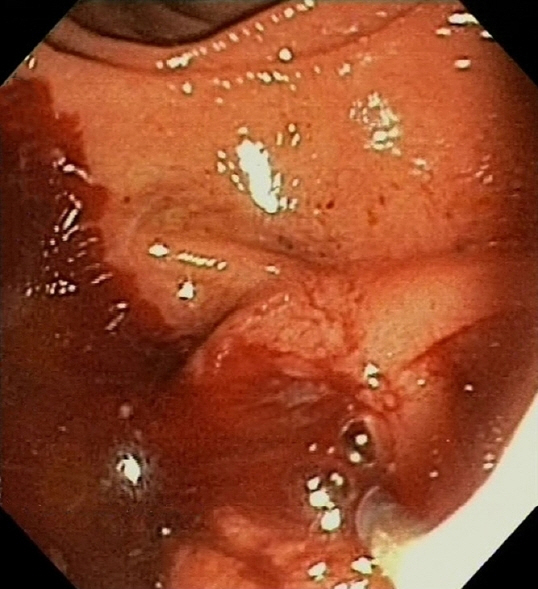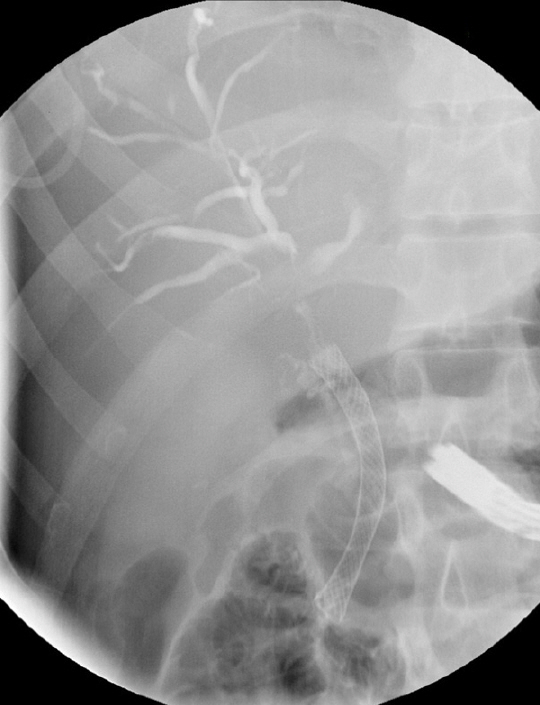Clin Endosc.
2023 Jul;56(4):521-526. 10.5946/ce.2021.276.
Portal cavernography during endoscopic retrograde cholangiopancreatography: from bilhemia to hemobilia
- Affiliations
-
- 1Department of Gastroenterology, Hepatopancreatology, and Digestive Oncology, Erasme University Hospital, Université Libre de Bruxelles, Brussels, Belgium
- 2Department of Gastroenterology and Digestive Oncology, Meuse and Sambre Regional Hospital Center, Namur, Belgium
- KMID: 2544575
- DOI: http://doi.org/10.5946/ce.2021.276
Abstract
- Portobiliary fistulas are rare but may lead to life-threatening complications. Biliary plastic stent-induced portobiliary fistulas during endoscopic retrograde cholangiopancreatography have been described. Herein, we present a case of portal cavernography and recurrent hemobilia after endoscopic retrograde cholangiopancreatography in which a portobiliary fistula was detected in a patient with portal biliopathy. This likely indicates a change in clinical presentation (from bilhemia to hemobilia) after biliary drainage that was successfully treated by placement of a fully covered, self-expandable metallic stent.
Keyword
Figure
Reference
-
1. Yamashita H, Chijiiwa K, Ogawa Y, et al. The internal biliary fistula: reappraisal of incidence, type, diagnosis and management of 33 consecutive cases. HPB Surg. 1997; 10:143–147.2. DiCocco JM, Fabian TC. Biliovenous fistula. In : Vincent JL, Hall JB, editors. Encyclopedia of intensive care medicine. Berlin: Springer;2012. p. 303–305.3. Huibregtse K, Gish R, Tytgat GN. A frightening event during endoscopic papillotomy. Gastrointest Endosc. 1988; 34:67–68.4. Ricci E, Mortilla MG, Conigliaro R, et al. Portal vein filling: a rare complication associated with ERCP for endoscopic biliary stent placement. Gastrointest Endosc. 1992; 38:524–525.5. Tighe M, Jacobson I. Bleeding from bile duct varices: an unexpected hazard during therapeutic ERCP. Gastrointest Endosc. 1996; 43:250–252.6. Kennedy C, Larvin M, Linsell J. Fatal hepatic air embolism following ERCP. Gastrointest Endosc. 1997; 45:187–188.7. Mutignani M, Shah SK, Bruni A, et al. Endoscopic treatment of extrahepatic bile duct strictures in patients with portal biliopathy carries a high risk of haemobilia: report of 3 cases. Dig Liver Dis. 2002; 34:587–591.8. Espinel J, Pinedo ME, Calleja JL. Portal vein filling: an unusual complication of needle-knife sphincterotomy. Endoscopy. 2007; 39 Suppl 1:E245.9. Layec S, D’Halluin PN, Pagenault M, et al. Massive hemobilia during extraction of a covered self-expandable metal stent in a patient with portal hypertensive biliopathy. Gastrointest Endosc. 2009; 70:555–556.10. Furuzono M, Hirata N, Saitou J, et al. A rare complication during ERCP and sphincterotomy: placement of an endoscopic nasobiliary drainage tube in the portal vein. Gastrointest Endosc. 2009; 70:588–590.11. Kawakami H, Kuwatani M, Kudo T, et al. Portobiliary fistula: unusual complication of wire-guided cannulation during endoscopic retrograde cholangiopancreatography. Endoscopy. 2011; 43 Suppl 2 UCTN:E98–E99.12. Kalaitzakis E, Stern N, Sturgess R. Portal vein cannulation: an uncommon complication of endoscopic retrograde cholangiopancreatography. World J Gastroenterol. 2011; 17:5131–5132.13. Dawwas MF, Oppong KW, John SK, et al. Endoscopic ultrasound diagnosis of an ERCP-related portobiliary fistula. Endoscopy. 2013; 45 Suppl 2 UCTN:E214–E216.14. So H, Song TJ, Lee D, et al. Endoscopic treatment of recurrent bleeding from a portobiliary fistula with a fully covered self-expandable metal stent. Endoscopy. 2015; 47 Suppl 1:E616–E617.
- Full Text Links
- Actions
-
Cited
- CITED
-
- Close
- Share
- Similar articles
-
- Delayed Severe Hemobilia after Endoscopic Biliary Plastic Stent Insertion
- Massive Hemobilia due to Hepatic Arteriobiliary Fistula during Endoscopic Retrograde Cholangiopancreatography: An Extremely Rare Guidewire-Related Complication
- Delayed Hemobilia Caused by Penetration of Biliary Plastic Stent into Portal Vein
- Pancreaticoduodenal artery pseudoaneurysm-induced hemobilia caused by a plastic biliary stent
- Two Cases of Xanthogranulomatous Cholecystitis and Gallbladder Cancer with Hemobilia






